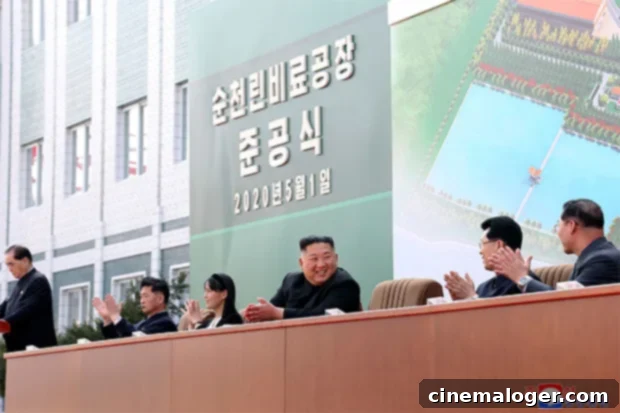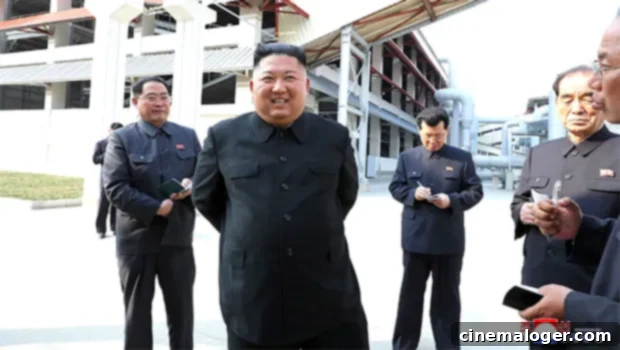North Korea’s Kim Jong-Un Ends 20-Day Absence, Appears at Fertilizer Plant Amid Intense Health Speculation
After a mysterious 20-day absence that fueled widespread rumors about his health and even his demise, North Korean leader Kim Jong-Un has reportedly made a public reappearance. Newly released photos from North Korea’s official Korean Central News Agency (KCNA) show the 36-year-old Supreme Leader at a ribbon-cutting ceremony for a fertilizer plant in Sunchon, beaming alongside his influential sister, Kim Yo Jong. This highly anticipated sighting aims to quell a storm of international speculation, yet it simultaneously raises new questions about the secretive state’s leadership and succession planning.
The images, which KCNA claims were taken on Friday, May 1, depict Kim Jong-Un in seemingly good spirits, interacting with officials and cutting a ceremonial red ribbon with his sister by his side. He is also seen standing outdoors at the new facility, suggesting an active engagement in the event. While these photos represent the first public glimpse of the leader in nearly three weeks, independent verification of the precise date and circumstances of the appearance remains challenging due to the tightly controlled nature of North Korean media. The choice of a fertilizer plant for his re-emergence is also significant, aligning with North Korea’s emphasis on agricultural self-sufficiency and economic development amidst international sanctions.
Kim Jong-Un’s disappearance from public view since April 11 had triggered an unprecedented flurry of unconfirmed reports and analyses across the globe. Speculation reached fever pitch when he notably missed the country’s most significant annual political holiday, the “Day of the Sun,” on April 15. This day commemorates the birthday of his grandfather and North Korea’s founder, Kim Il-sung, who passed away in 1994. Given the immense symbolic importance of this event for the Kim dynasty, his absence sent shockwaves through international intelligence communities and global media outlets, sparking intense debate about the stability of the nuclear-armed nation.
Rumors escalated rapidly, ranging from reports of a successful but debilitating cardiovascular procedure to claims of him being in a “vegetative state” or even deceased. Various media outlets cited anonymous U.S. and South Korean intelligence sources, as well as reports from North Korean defectors, feeding into the uncertainty. Some unconfirmed accounts suggested that he had undergone heart surgery and was recovering at a villa outside Pyongyang, while others speculated about a Chinese medical team being dispatched to assist. The sheer volume and conflicting nature of these reports underscored the profound difficulty in obtaining reliable information from the notoriously opaque regime, leaving the world to piece together fragmented clues and engage in informed guesswork.
During his prolonged absence, the global financial markets reacted to the uncertainty, and world leaders expressed concern over potential power vacuums or instability in a country possessing nuclear weapons. Neighbouring nations, particularly South Korea and China, closely monitored the situation, aware of the potential for profound regional ramifications. Despite the international frenzy, North Korea itself remained largely silent through its official channels regarding its leader’s whereabouts or health. However, KCNA did continue to issue reports and messages in Kim Jong-Un’s name during this period, including sending gifts and letters, a subtle but clear effort to project an image of continuity and stable leadership.
The decision to feature Kim Yo Jong prominently alongside her brother in the reappearance photos is highly symbolic and further solidifies her growing stature within the North Korean hierarchy. Already recognized for her increasing influence, having issued several high-profile statements in recent months, her visible presence at this pivotal moment reinforces her position as a key confidante and potential successor. Analysts widely interpret her elevated role as a clear indication that she is being groomed for significant leadership responsibilities, potentially even as a regent or the ultimate successor, should her brother’s health remain a concern. Her calm demeanor and close proximity to Kim Jong-Un serve to project an image of familial unity and strong, unchallenged leadership.
KCNA’s effusive description of the event further attempts to reinforce the narrative of a beloved and healthy leader. According to reports cited by the New York Times, the official agency stated that “All the participants again burst into thunderous cheers of ‘hurrah’,” upon seeing Kim Jong-Un, adding that he “warmly acknowledged the builders and masses raising thunderous cheers.” Such hyperbolic language is characteristic of North Korean propaganda, designed to cultivate an tremendous image of the leader as revered and indispensable. Notably, no outside press was reported to be on-site for the event, a common practice for KCNA, which typically releases its own controlled narrative and accompanying imagery a day or more after the purported events.

Beyond simply confirming his existence, Kim Jong-Un’s reappearance offers crucial insights into the inner workings of North Korea. It underscores the regime’s strategy of deliberate opacity, using silence and carefully curated media releases to control information both internally and externally. The incident also highlights the enduring global interest and concern surrounding the health and stability of the leader of a nuclear power. While the immediate crisis of his perceived disappearance seems to have passed, the episode has undoubtedly brought the question of succession to the forefront of international discussions, particularly concerning the preparedness and capabilities of Kim Yo Jong.
The world’s relief at Kim Jong-Un’s visible health is tempered by an understanding that the underlying vulnerabilities of North Korea’s leadership structure remain. His prolonged absence served as a stark reminder of the potential for instability in a state where power is so heavily centralized in one individual. Moving forward, observers will continue to scrutinize every detail of his public appearances for further clues about his health and the trajectory of his regime. The Sunchon fertilizer plant event, therefore, is not merely a ribbon-cutting ceremony; it is a meticulously crafted statement from Pyongyang, aimed at reassuring its populace and sending a clear, albeit carefully managed, signal of continuity to the international community.
Ultimately, Kim Jong-Un’s return to the public eye, despite the official fanfare, does not entirely erase the questions posed by his disappearance. It serves as a potent reminder of the inherent risks associated with a closed system of governance and the immense geopolitical implications of any perceived instability at the helm of a nuclear state. The saga of his 20-day absence will undoubtedly influence how international actors approach diplomacy and engagement with North Korea in the coming months and years, with an even keener eye on the dynamic between Kim Jong-Un and his increasingly prominent sister, Kim Yo Jong.
